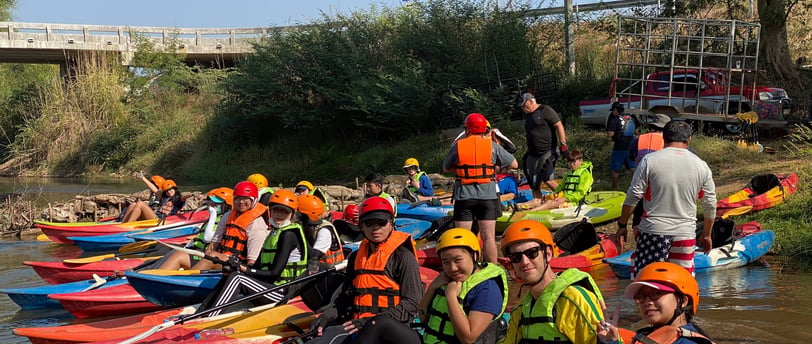Group management and safety Kayaking
Kayaking on a river
Martin Cudworth, Dave Lucas
5/2/20242 min read


Group management and safety is crucial when kayaking on a river with a group. To ensure a smooth and enjoyable experience, it is important to establish some good ground rules with your group. We should always use the Acronym of C.L.A.P. But what does this stand for and how is it relevant for your group.
Communication we need to establish clear communication, this can be done in several ways radio, whistles, hand signals, paddle signals and voices but there is more to communicating than that. How about before the trip are we checking conditions and letting people know our planned route? Even after we will be debriefing and reflecting as this locks in the days events so the next time they paddle together they will be used to the events and start to form a efficient team.
Line of sight, This should addressed before setting off, I usually gather everyone together and discuss the route, potential hazards, and safety protocols. Assign a leader who will be responsible for making decisions and guiding the group. Sometimes the person out front ends up being the paddler who is the most nervous. They paddle along, often with a tight grip on the paddle not comfortable enough with their skills to turn around for fear of capsizing. As the rapids increase they tend to go faster, their focus becomes more on survival than group awareness. This leads to the group getting spaced out over a large area with some paddlers increasing speed in an attempt to keep up with the lead while others, often new paddlers who have still to develop a strong forward stroke, trail at the rear. This can be problematic as those in the rear can sometimes be more likely to capsize because of their experience level. This type of situation could be avoided by regularly practicing CLAP.
Awareness, not only do we need to be aware of the potential hazards on the water we should be thinking about things long before our arrival at the put in. With good awareness we will have checked the conditions, the weather, water levels and the current. We should also consider the distance and maybe a few different put out areas in case you need to shorten the route. Also we need to take in to consideration the skill level of the group and that they appropriately dressed with the correct gear. It is essential to maintain a safe distance between kayaks to avoid collisions and allow for easy maneuvering. Keep an eye on everyone in the group, especially beginners or those less experienced in kayaking, to ensure their safety. Awareness is all encompassing.
Position, Or as I like to refer the position of maximum usefulness The position of maximum use is a variable and not only depends on where people are paddling but also on a paddler’s individual skills. For example, what about the person in the front of the group leading paddlers on a trip? What is their responsibility in this position? Besides needing to know the destination and route choice they need to be comfortable enough to actually be turning around regularly. I often like to be the paddler who is able to float between the front and the back of the group so I can assess where I am needed the most and also so I can communicate with each member of the group.
Lastly encourage the use of life jackets and provide necessary equipment like helmets and paddles. Regularly check in with each member to ensure their comfort and address any concerns. By prioritizing group management and safety, everyone can enjoy a fantastic kayaking adventure on the river.
